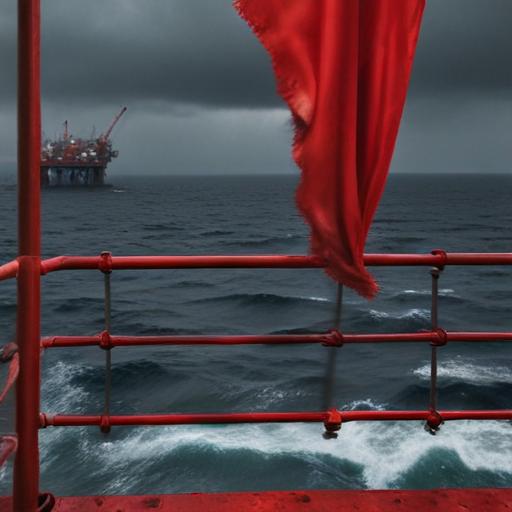Summary: Greenpeace climbers unveil Anish Kapoor’s installation BUTCHERED on a Shell North Sea platform, turning a 12m by 8m canvas into a blood-red statement about the climate damage caused by fossil fuels. The act, the first artwork mounted on an active offshore gas site, ties symbolic protest to escalating heatwaves, floods and droughts worldwide, and calls for accountability and reparations from industry.
Greenpeace climbers have installed a major new work by renowned artist Anish Kapoor onto a Shell platform in the North Sea, marking what organizers say is the world’s first artwork placed at an active offshore gas site. Kapoor’s piece, titled BUTCHERED and conceived specifically for this action, is intended as a stark visual response to the climate damage linked to fossil fuels and a cry for reparations for affected communities.
To install the artwork, seven Greenpeace climbers scaled the Skiff platform, roughly 45 nautical miles off the Norfolk coast. They fastened a giant canvas measuring 12 metres by 8 metres to the side of the structure and hoisted a high-pressure hose to a point about 16 metres above the sea. A thousand litres of a blood-red liquid—designed for this installation—were pumped into the fabric, creating a large crimson stain. The fluid is described as a non-toxic mix of seawater, beetroot powder and food-based pond dye, formulated to disperse safely and with minimal environmental impact.
Images accompanying the piece show the lemon-bright juxtaposition of art against industrial steel, with Kapoor explaining that the work visualizes the wound inflicted on humanity and the planet by fossil fuel extraction. “The carbon dioxide released by burning fossil fuels is invisible, but we are witnessing the devastation that its extraction wreaks on our world,” he said. “BUTCHERED aims to bring home the horror, giving voice to the moral and physical destruction caused by ruthless profiteers.” He also paid tribute to activists who contest destructive energy practices and disobey when necessary.
The action comes amid a climate crisis backdrop: continuing heatwaves, wildfires and floods affecting communities in the UK and around the world. Greenpeace notes that Europe is seeing record heat and fires, while other regions have faced deadly floods and droughts, with deadly weather events affecting China, India and many other countries.
Greenpeace UK’s Philip Evans framed the protest as a call for accountability. “Extreme weather is hitting close to home, but the extraction of fossil fuels driving the climate crisis is often out of sight,” he said. “While the fossil fuel sector makes billions from climate destruction, ordinary people bear rising costs from flood damage, drought and wildfires. Governments must hold oil giants to account and make them pay for the damage they’ve caused.”
The artwork is part of Greenpeace’s Polluters Pay Pact, a broad initiative urging governments to adopt policies that require big polluters to finance climate damages. Greenpeace argues for measures such as a climate damages tax on fossil fuel extraction and shareholder taxes to raise funds for affected communities at home and abroad. The campaign suggests substantial global public support for government action to hold oil and gas companies financially responsible for climate-related harm.
Context around Shell’s role in the climate conversation features prominently in Greenpeace’s materials. The charity cites Shell’s profits in the wake of geopolitical events, noting significant earnings alongside comparatively modest UK tax contributions over that period. Greenpeace also points to estimates of climate damages linked to fossil fuel activity and highlights ongoing expansion plans, including hundreds of new oil and gas projects in the pipeline, underscoring the tension between industry growth and climate risk.
Greenpeace notes that the Global South bears the brunt of climate impacts despite contributing a smaller share of global greenhouse gas emissions, calling for a more equitable approach to climate finance and responsibility. Kapoor’s partnership with Greenpeace adds to his prior public calls for the oil industry to confront its role in climate destruction, including past advocacy for Britain’s National Portrait Gallery to rethink ties with oil giant BP.
This action situates art within direct protest against fossil fuels, pairing a provocative visual statement with ongoing calls for policy change. It also serves as a reminder of the active opposition to fossil fuel expansion and the broader push for accountability, reparations and a transition toward sustainable energy.
What this could mean going forward:
– Heightened media attention on corporate climate responsibilities and the concept of “polluter pays” in policy debates.
– Continued use of high-visibility art and performance as tools for environmental advocacy, potentially influencing public opinion and political pressure.
– Ongoing scrutiny of oil and gas industry profitability versus social and environmental costs, with calls for a stronger fiscal framework to support climate resilience in communities most at risk.
If you’re looking for a concise takeaway: the act blends art and protest to spotlight climate harm, urging governments and corporations to acknowledge damage and fund solutions, while reinforcing the urgency of a rapid shift away from fossil fuels.
